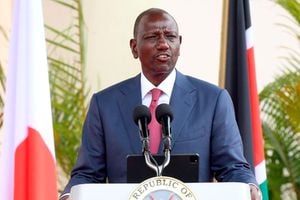Relief to consumers as Treasury halves tax on cooking gas

The Treasury has cut VAT charged on cooking gas by half, handing consumers a major relief amid rising global prices of the commodity and other petroleum products.
The Treasury has cut value-added tax (VAT) charged on cooking gas by half, handing consumers a major relief amid rising global prices of the commodity and other petroleum products.
The Finance Act 2022 cut the tax on liquefied petroleum gas (LPG) supplies from the current 16 per cent to eight per cent.
“Section 5 of the Value Added Tax Act, 2013 is amended in sub-section 2 by adding the following new paragraph immediately after paragraph(aa)-(ab) in the case of the supply of liquefied petroleum gas including propane; eight per cent,” the new law signed by President Uhuru Kenyatta last week said in part.
The significant cut comes a year after Parliament reinstated the 16 per cent VAT on cooking gas, which together with the rally in crude prices, has seen the cost of the 13-kg LPG rise by Sh900 since June last year.
Kenyan households had since June 2016 enjoyed low cooking gas prices after the Treasury scrapped the tax on LPG to cut costs and boost uptake among the poor who rely on dirty kerosene and charcoal for cooking. Market data shows that prices for the 13-kg cooking gas fell to under Sh2,000 in October 2016 after the Treasury scrapped the 16 per cent VAT.
Highest level in Kenya’s history
Costly crude oil in the wake of the Russian invasion of Ukraine, the imposition of VAT, and the search for higher margins by dealers have, however, combined to send cooking gas prices to their highest level in Kenya’s history.
The tax cut will bring some relief to households at a time international crude prices are rising — leaving consumers at the mercy of dealers who exploit market dynamics to make a kill since LPG prices, unlike other petroleum products, are not controlled.
The cut on VAT on LPG adds to ongoing efforts by the State to make the commodity affordable to households.
The State plans to revive a subsidy scheme for LPG supplies starting July this year. Some 60,000 six-kilogramme LPG cylinders are set to be distributed in the initial phase of the State’s subsidy scheme for affordable cooking gas.
Smart meters
The Petroleum ministry has already invited bids for supply of smart meters to be fitted on the cylinders that will be distributed among low-income households in the country.
The Treasury allocated Sh470 million towards the revival of the LPG subsidy scheme in its expenditure plan for the new financial year starting July — a substantial increase compared to the Sh155 million that had been apportioned towards the cause in the current financial year.
A plan released by Treasury Cabinet Secretary Ukur Yattani last November indicated that the State would distribute 300,000 units of 6-kg LPG cylinders to low-income households in the next three years.
The revival of the LPG subsidy scheme would come as a major relief for households pressured by the present high prices of the commodity.
Convenient and cleaner
LPG is the preferred energy source for households that can afford it in major towns due to its convenience and because it is cleaner than other cooking fuels.
Under the initial subsidy scheme, the beneficiaries were to pay a discounted price of Sh2,000 in three years for the burner and cylinder, with refills pegged at Sh840 at the time.
The implementation of the scheme was however hindered by some suppliers who provided faulty cylinders.
The plan was also adversely affected by distribution challenges at the State-owned National Oil Corporation which was to drive the programme.





